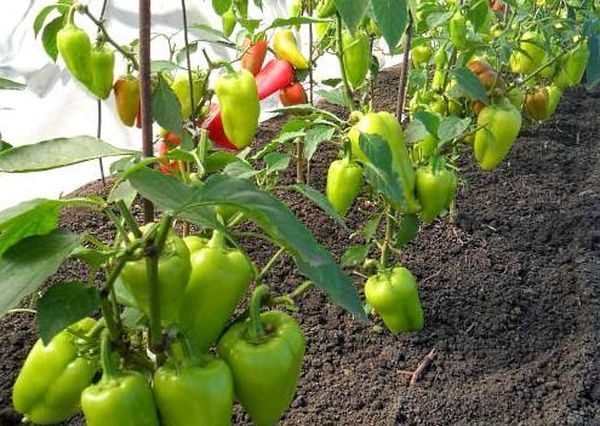 It is almost impossible to grow a good crop of peppers without the help of fertilizing. This vegetable crop is considered capricious and reacts sharply to the smallest lack of trace elements in the soil, so plants require additional nutrition.
It is almost impossible to grow a good crop of peppers without the help of fertilizing. This vegetable crop is considered capricious and reacts sharply to the smallest lack of trace elements in the soil, so plants require additional nutrition.
Of the additives, various mineral and organic fertilizers are used, as well as folk remedies. To begin to feed seedlings of peppers and subsequently collect a rich harvest, you need to study the composition of the fertilizer and its properties.
Content
Pepper feeding according to height
Each top dressing has specific features and is used only in a certain time interval. It is determined depending on the phase of development of the pepper: the growth of green mass, the development of shoots, flowering or fruiting. For example, nitrogen is used at the initial stage of cultivation, potassium and phosphorus - during the formation of ovaries and fruits. There are fertilizers that have a universal effect and are used regardless of growth (complex additives, folk remedies).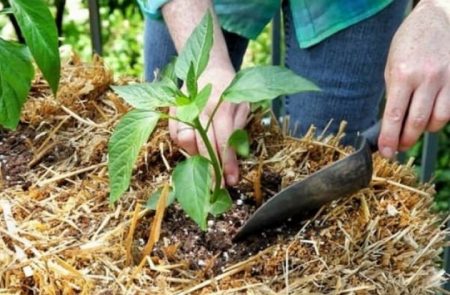
Mineral fertilizers
Minerals are one of the most important components that affect the quality of the fruit, as well as their quantity. Mineral components include:
Nitrogen
Peppers need it for a set of green mass, the formation of ovaries, provides the growth of stems.
Phosphorus
The element contributes to the development of the root system, is responsible for the formation of fruits and their ripening period.
Potassium
This compound is considered a fundamental component for the appearance of pepper. Potassium affects the color intensity, the correct shape and size of the vegetable.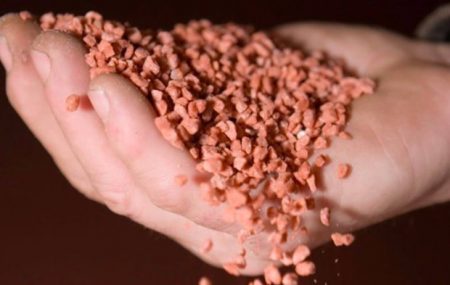
Magnesium
The substance is an additional source of nutrition for the root system, and also helps maintain the mineral balance in the earth.
Top dressing in spring after transplantation
When the peppers are already transplanted into the ground, after 2 weeks they begin to fertilize the earth. The first to make nitrogen fertilizers. These include urea and ammonium nitrate.
Urea dressing
10 grams of urea are diluted in 10 liters, the solution is poured into a watering can and the pepper is watered under the root. The consumption rate per plant is 0.5 liters.
Urea can irrigate the leaves and stalk of peppers. The plant perceives foliar feeding well. Fertilizer can be used in dry form, it is enough to distribute it on moistened soil with a thin layer near the stem and in the aisles. There are 7-8 grams of powder per square meter of soil.
Ammonium nitrate
Another, no less effective, fertilizer for the crop is ammonium nitrate. In chemical properties, nitrate is more aggressive than urea. In its dry form, it is rarely used, often in a diluted state and for root dressing. A tablespoon of the substance is bred on a bucket of water and the peppers are watered 2-3 weeks after planting in the greenhouse. The treatment is repeated after 10-14 days.
Top dressing is carried out only in the morning or in the evening. Watering is not carried out during the day, as there is a possibility of getting a burn.
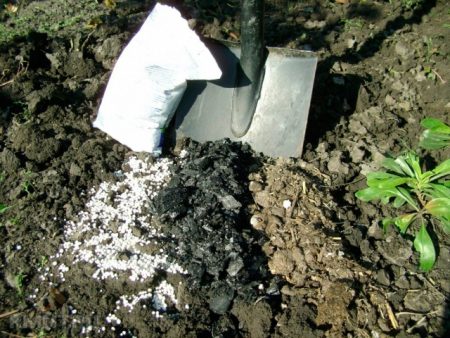
During flowering and ovary formation
When the peppers are already overgrown with green leaves, and the stems become powerful, the second phase of cultivation begins. In importance, it is more important than the first, since it is during this period that the future crop is laid. Since the second half of June, top dressing is carried out using phosphorus and potassium supplements.Prepare a nutrient solution: mix in a bucket of water for a tablespoon of superphosphate and potassium sulfate. Water the resulting solution of the plant 1 time in 10-14 days 2 times: the first time before flowering, the second time during the formation of the ovaries.
Potassium humate is also excellent for this period of active growth of peppers, as it increases soil fertility. 3 grams of humate is dissolved in 10 liters of water and irrigated with shoots. Humate is not recommended to be combined with phosphate fertilizers. Processing is carried out 3 times per season: before the onset of flowering, during the formation of ovaries and during fruiting.
During fruiting
During fruiting, it is recommended to use potassium top dressing in combination with nitrogen fertilizers to quickly ripen the fruit. Potassium nitrate is a substance that contains both potassium and nitrogen. It is bred in the amount of 15 grams per 10 liters and adult plants are watered under a bush. Potassium nitrate is suitable for irrigating foliage, the effect is the same as with root feeding.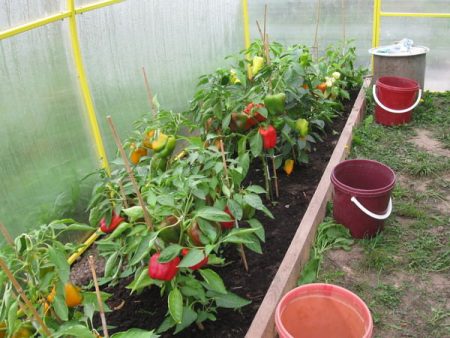
Ammonium sulfate will make up for the lack of nitrogen in the soil, and sulfur will extend the fruiting period and improve the palatability of the fruit. The substance can be added to mulch (40 grams per meter of land). Top dressing is completely safe for peppers, all components are quickly distributed in the soil, without the formation of toxins and by-products.
Organic matter
A supplement with a natural organic composition is of particular value for seedlings of peppers. To obtain a high quality crop, it is enough to use organic fertilizing 3-4 times throughout the season. Organic fertilizers, like mineral fertilizers, are applied at a certain time, since their composition varies.
Mullein
A universal product used as a feed for most nightshade crops, including peppers. Fertilizer consists of a large number of minerals (nitrogen, potassium, calcium, phosphorus). Once in the ground, it increases the level of humus, which determines the fertility of the earth. The optimal time for feeding cow dung comes at the end of May. During this period, peppers need a powerful growth stimulator and strengthen immune abilities. 5 parts of water take 1 part of mullein, the mixture is insisted for 5-6 days. During fermentation, gas is released and the color of the fertilizer changes from brown to light yellow. Dilute the solution another 5 times and start watering. Mullein is watered under the root, but foliar top dressing with a similar solution is also possible. Mullein treatment is repeated 2 weeks after the first feeding.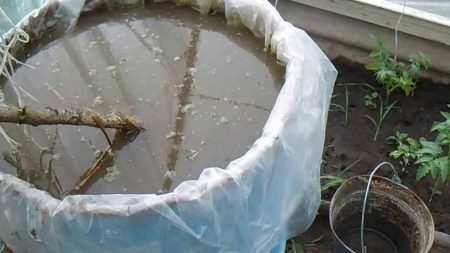
To neutralize the unpleasant smell of mullein, a teaspoon of copper sulfate is added to a freshly prepared solution.
Ash
Since ash contains a large amount of minerals, it is often used as fertilizer. They begin to feed with fertilizer from the pepper transplant itself. A glass of ash is bred in a bucket of water and the plants are watered several days after transplantation. Before flowering, ash can be applied to the leaves and stem. It protects peppers from attack by pests and insects, and also prevents the occurrence of fungal diseases. Such fertilizer can be added to the mulch and sprinkled with aisle from time to time.
Iodine
The substance has antibacterial properties, and also affects the taste of the pulp and improves the quality of the fruit. Iodine is used at the beginning of growing peppers. 3-4 drops of iodine solution are added to a liter of water and applied to shoots and leaves. Iodine leads to the death of pathogenic microflora, prevents the attack of insects. The substance can be used up to 4 times throughout the season, with an interval of 2 weeks.
Eggshell
The source of calcium for peppers can serve as crushed shells.The shell from boiled eggs is dried and crushed with a crush. The crushed powder is poured into the aisles, regardless of the time of growing seedlings. You can prepare a liquid fertilizer for irrigation: mix the shell with water in a ratio of 1: 3. Peppers are watered during flowering and fruiting under the root. Calcium is easily washed out of the soil with each watering, so the need for an element arises constantly. The shell can be added to the mulch, as well as before planting peppers.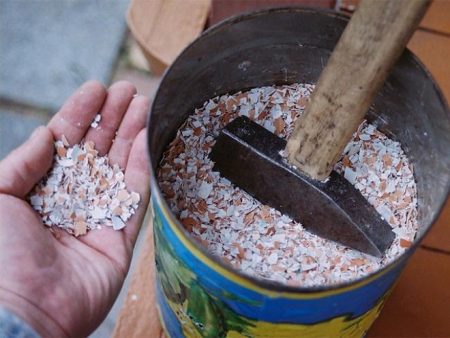
Yeast
Once in the ground, the yeast begins to process organic components, resulting in the release of nitrogen and potassium. Yeast top dressing will be especially relevant immediately after transplanting peppers to a permanent place. A bag of dry yeast and a tablespoon of sugar are taken for 10 liters of warm water. All ingredients are mixed and left to infuse for 2-3 hours in a warm place. After time, the resulting mixture is diluted 5 times and watered under the root. To enhance the growth of peppers and the rapid formation of ovaries, the supplement is used 3 times: 1 time after planting, 2 and 3 times after flowering and before fruiting.
Yeast is a good complementary product when feeding, so it is used in alternation with mineral or complex fertilizers.
Complex feeding
The complex is a complex mixture, which includes mineral substances in a certain proportion. They have a wide spectrum of action and instantly nourish the soil, replenishing its mineral balance. The complexes are easy to use, soluble in the aquatic environment and are used throughout the time of growing seedlings: from planting to fruiting.
Agricola
The additive is popular with most gardeners. It has no poisons; it is safe for plants and fruits. Its action is aimed at accelerating fruiting, increasing productivity. For the entire season, 3-4 feeding is carried out with an interval of 2 weeks. 25 grams of the substance is stirred in 10 liters of water and the seedlings are watered, starting from 3 weeks after transplanting into the greenhouse.
Effecton-o
The fertilizer contains phosphorus and potassium in the composition, is more suitable for use in the second phase of cultivation - during flowering and the formation of ovaries. The main purpose of the product is foliar top dressing. The solution is prepared by mixing 2 tablespoons of granular mixture and 10 liters of water. Effekton is used no more than 3 times throughout the season.
Baikal
Fertilizer is mainly used at the beginning of seedling cultivation, as it intensively nourishes the root system and provides early flowering. Baikal is diluted in the aquatic environment in a ratio of 1: 1000. Watering is carried out a couple of weeks after planting peppers in a greenhouse or greenhouse. Repeat the treatment after 14 days.
The main rule in the successful cultivation of peppers is the proper use of fertilizer. For it to really work, it is bred in the right proportion and used for irrigation or irrigation in a given time interval. If the seedlings themselves are rapidly developing and growing well, no need to apply top dressing. Excess minerals in the soil lead to withering and death of the crop.




 Calorie pepper stuffed with meat and rice - BZHU per 100 grams
Calorie pepper stuffed with meat and rice - BZHU per 100 grams Gorky pepper - the best varieties for open ground
Gorky pepper - the best varieties for open ground Hot pepper seeds - the best varieties for open ground and reviews
Hot pepper seeds - the best varieties for open ground and reviews Capsicum tincture for hair - how to use and reviews
Capsicum tincture for hair - how to use and reviews
Ts
thank